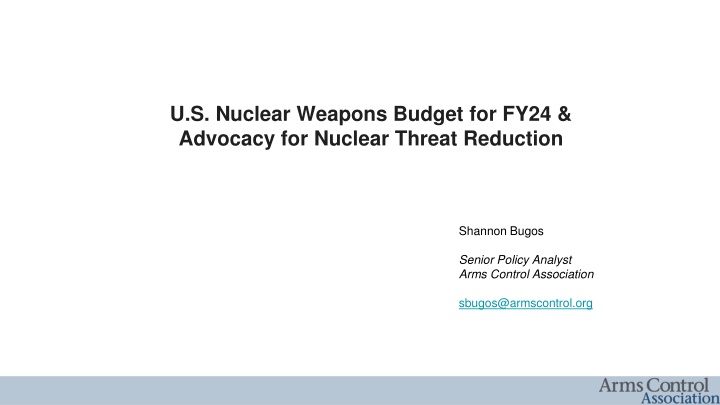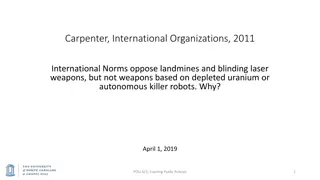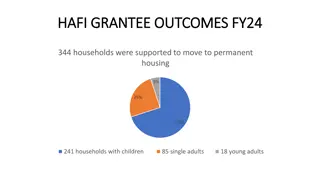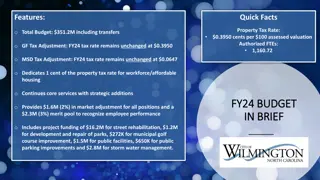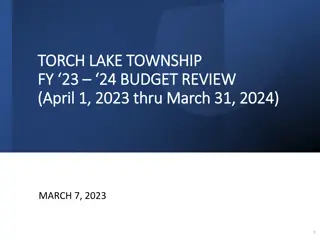U.S. Nuclear Weapons Budget for FY24 & Advocacy for Nuclear Threat Reduction Overview
The Fiscal Year 2024 budget for U.S. nuclear weapons activities is $56.6 billion, up by 11% from the FY23 request. The budget includes allocations for the Energy Department, Defense Department, and National Nuclear Security Administration for various nuclear weapon delivery systems and warheads. The Defense Department's program branches outline requests for Air Force, Navy, and specific nuclear weapon systems. The National Nuclear Security Administration's warhead carrier requests cover various aspects of nuclear weapons modernization. The process of U.S. defense budget approval involves multiple steps in Congress. Overall, the budget process and allocation details underscore the ongoing emphasis on nuclear deterrence and modernization efforts in the U.S.
Download Presentation

Please find below an Image/Link to download the presentation.
The content on the website is provided AS IS for your information and personal use only. It may not be sold, licensed, or shared on other websites without obtaining consent from the author.If you encounter any issues during the download, it is possible that the publisher has removed the file from their server.
You are allowed to download the files provided on this website for personal or commercial use, subject to the condition that they are used lawfully. All files are the property of their respective owners.
The content on the website is provided AS IS for your information and personal use only. It may not be sold, licensed, or shared on other websites without obtaining consent from the author.
E N D
Presentation Transcript
U.S. Nuclear Weapons Budget for FY24 & Advocacy for Nuclear Threat Reduction Shannon Bugos Senior Policy Analyst Arms Control Association sbugos@armscontrol.org
Fiscal Year 2024 Total Nuclear Weapons Activities $56.6b +11% from FY23 request of $50.9b Energy Department Defense Department $37.7b National Nuclear Security Administration $18.8b Nuclear Weapon Delivery Systems Nuclear Warheads
Defense Department Program Branch Description FY24 Request Air Force $4.3b Ground-Based Strategic Deterrent (Sentinel) Replacement for Minuteman III ICBMs Planned purchase of ~650 ICBMs R&D and Procurement Air Force $5.3b Replacement for B-1B (conventional) and B-2 (nuclear) Planned purchase of at least ~100 bombers B-21 Raider strategic bomber R&D and Procurement Navy $6.1b Columbia-class ballistic submarine Replacement for Ohio-class SSBNs Planned purchase of 12 subs R&D and Procurement Air Force $978m AGM-181 Long Range Standoff Weapon Replacement for AGM-86B air-launched cruise missile (ALCM) Compatible with B-21 and B-52H bombers Planned purchase of ~1000 missiles R&D and Procurement Navy $0 New nuclear weapon delivery system Retired in 2010 Nuclear Sea-Launched Cruise Missile
National Nuclear Security Administration Warhead Carrier FY24 Request Long Range Standoff Weapon (ALCM) $1b W80-4 LEP New SLCM $0 W80-4 Alt-SLCM Sentinel ICBMs $1.1b W87-1 Mod Trident SLBMs $178m W88 Alt 370 Trident SLBMs $390m W93 B-2 and B-21 bombers (+ select U.S./allied tactical aircraft) $450m B61-12 LEP B-2 bomber $31m for safe sustainment, not life extension B83 Sustainment
Broad Overview of U.S. Defense Budget Process White House Request Congressional Committees President s Desk House & Senate Floor National Defense Authorization Act The administration submits a budget request for each executive department or agency. After the relevant committees pass the legislation out of committee (and hold bipartisan, bicameral conferences to hammer out any differences between House and Senate versions), the legislation then goes to the floor for a vote by the entire House and the entire Senate. Signed into law or vetoed. House Armed Services Committee & Senate Armed Services Committee Defense and E&W Appropriations House Appropriations Committee & Senate Appropriations Committee
